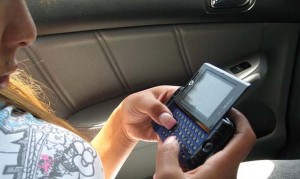
A new set of "voluntary" federal guidelines would limit texting and the use of other distracting technologies while driving.
With the nation’s top automotive safety regulator calling distracted driving an “epidemic,” the Obama Administration is demanding that automakers put a limit on technologies that permit motorists to text or make cellphone calls while driving.
Transportation Secretary Ray LaHood today outlined a series of voluntary steps for automotive manufacturers that would focus on the safe use of in-car infotainment systems. The proposal would impact navigation and entertainment systems but would put a particular focus on the use of cellphones for texting and voice calling.
“Distracted driving is a dangerous and deadly habit on America’s roadways,” said LaHood, explaining, “That’s why I’ve made it a priority to encourage people to stay focused behind the wheel.”
The Department of Transportation proposal would nonetheless be far less draconian than the guidelines called for by the Transportation Safety Board late last year. That proposal would have effectively barred the use of cellphones –both hands-free and handheld – entirely by anyone sitting behind the wheel.
But both agencies clearly believe that something has to be done to deal with distracted driving – which the Dept. of Transportation linked to 3,092 U.S. highway deaths in 2010, the latest year for which figures are available. And government officials believe that figure may err on the low side as it can be difficult to prove that a crash was, in fact, the result of distracted driving,.
While surveys show that most motorists use cellphones at least occasionally, there’s a growing public consensus that something must be done, likely encouraged by the fact that most motorists have also experienced dangerous situations created by a driver distracted while using a cellphone.
The proposal unveiled by LaHood would ask automakers to disable in-vehicle electronic systems that could be used by the driver while the vehicle is moving if they could cause “undue distraction” and are not relevant to the safe operation of a vehicle. Among other things, that would bar text messaging, Internet browsing and the use of social media.
The latter issue has become a red flag for safety advocates as several makers have introduced systems allowing text messages and social media posts to be red to the motorists using artificial text-to-voice technology. Some of those systems also allow a motorist to reply – though usually by triggering one of a handful of pre-programmed responses.
Manufacturers have become well aware of the growing concerns about distracted driving and have said they are looking for ways to ensure their newest technologies are safe to use. Among other things, they have been emphasizing systems – such as the Ford Sync, Hyundai BlueLink and Toyota EnForm – that rely on voice, rather than hands-on controls.
But LaHood and other safety advocates have questioned whether such technologies go far enough to ensure drivers keep their eyes on the road and their hands upon the wheel.
Nonetheless, the latest DoT proposal is seen as a compromise that would not bar manufacturers from selling their increasingly popular – and profitable – in-car infotainment systems.
That could limit objections by the industry during the mandated 60-day public comment period before any new guidelines could go into effect. The National Highway Traffic Safety Administration will, meanwhile, hold a series of hearings around the country to gauge reaction to the new rules.
Separately, more and more states are acting on their own to address high-tech safety concerns. Hearings now underway could lead Alabama to become the latest state to ban texting while driving.
